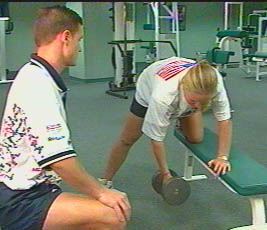|
Periodization Training
|
 |
If that sounds interesting, the first question to answer is what exactly is a "periodization training program"? It’s actually a simple concept. Periodization training means training in stages to increase tennis fitness. The type and amount of training progresses as you move through the stages. By training in these progressive stages, you develop the ability to peak for competition. It could be a series of tournaments, a USTA league season, or your club championship. The length and intensity of the stages are custom designed around your schedule, to maximize results.
This training program has been developed by some of the top coaches in the country and followed by dozens of elite players. We’ve proved it’s value over and over again as part of the USTA player development program. Now we’ll show you how it can work for you. Follow it and you’ll see real improvements in your level of play and more importantly, you will be able to time your absolute best performances for when it matters most.
 |
To be effective, a periodization training program must be designed for the specific physical requirements of tennis. In this first article I want to outline the elements that make up superior tennis fitness. Subsequent articles will describe the four stage program we use with top American players in the USTA Player Development Program and outline a wide variety of exercises used to develop tennis fitness. Then I’ll show you how to put these exercises together into your own 4-stage program, custom designed for your level and personal competitive schedule.
So what exactly does it mean to be in top condition for tennis? In the USTA player development program we have identified the following specific components that comprise excellent tennis fitness:
1. Flexibility - A flexible, unrestricted range of motion in the joints will help prevent injury and improve overall performance.
2. Strength and Endurance - A tough match requires you to hit hundreds of balls. Tennis stength is the ability to hit the ball hard. Endurance is the ability to hit your shots as hard at the end of a long match as at the beginning.
3. Power - Power means the ability to execute explosive movements quickly with minimum effort, such as an explosive first step. Both upper and lower body power are key in tennis fitness.
 |
4. Agility and Speed - Research shows a five second point can require as many as four direction changes. That’s about one direction change every second! Agility and speed are crucial to movement and the ability to position yourself and to hit off a solid platform.
<% ns_puts [nsv_get mkm_includes mkm_oldContentFooter_inc] %>
 What’s the fastest way to make a real
jump in your level of play? You’ve taken lessons, dissected your technique, maybe
you’ve read every lesson in the TennisONE library. But are you ready to try a
completely different approach to improve results? Periodization training could raise your
game 10% or more, without making any other changes in your strokes and strategy.
That could be the difference in advancing an entire level in NTRP play, from a 3.5 league
to a 4.0, or from 4.0 to 4.5.
What’s the fastest way to make a real
jump in your level of play? You’ve taken lessons, dissected your technique, maybe
you’ve read every lesson in the TennisONE library. But are you ready to try a
completely different approach to improve results? Periodization training could raise your
game 10% or more, without making any other changes in your strokes and strategy.
That could be the difference in advancing an entire level in NTRP play, from a 3.5 league
to a 4.0, or from 4.0 to 4.5.